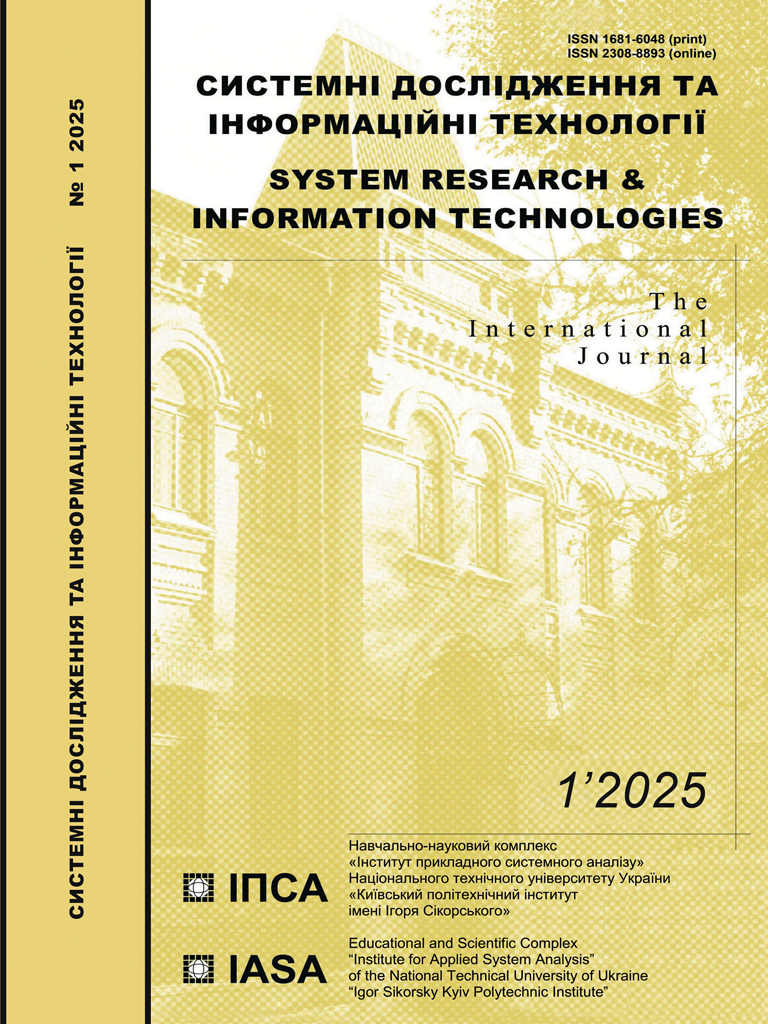Identification of nonlinear systems with periodic external actions (Part III)
DOI:
https://doi.org/10.20535/SRIT.2308-8893.2025.1.04Keywords:
identification, ordinary differential equation, periodic coefficient, constant coefficient, uniformly distributed noiseAbstract
The article considers the problem of identifying a mathematical model in the form of a system of ordinary differential equations. The identified system can have constant and periodic coefficients. The source of information for solving the problem is time series of observed variables. The article studies the effect of uniformly distributed noise on the identification result. To solve the problem, the algorithm proposed by the author in previous works was used. It is shown that the method has different sensitivity to noise depending on which of the observed variables is contaminated with noise. The implementation of the method is illustrated by numerical examples of identifying nonlinear differential equations with polynomial right-hand sides.
References
P.R. Deboeck, S.M. Boker, “Modeling noisy data with differential equations using observed and expected matrices,” Psychometrika, vol. 75, no. 3, pp. 420–437, Sept. 2010. doi: 10.1007/S11336-010-9168-2
H. Liang, H. Miao, and H. Wu, “Estimation of constant and time-varying dynamic parameters of HIV infection in a nonlinear differential equation model,” Ann. Appl. Stat., no. 4(1), pp. 460–483, Mar. 1, 2010. doi: 10.1214/09-AOAS290
J.O. Ramsay, G. Hooker, D. Campbell, and J. Cao, “Parameter estimation for differential equations: a generalized smoothing approach,” J. Roy. Statistic. Soc., Ser. B, vol. 69, no. 5, pp. 741–796, Nov. 2007. doi: 10.1111/j.1467-9868.2007.00610.x
V. Gorodetskyi, “Identification of nonlinear systems with periodic external actions (Part 1),” System Research & Information Technologies, no. 3, pp. 93–106, 2024. doi: 10.20535/SRIT.2308-8893.2024.3.06
V. Gorodetskyi, “Identification of nonlinear systems with periodic external actions (Part 2),” System Research & Information Technologies, no. 4, pp. 66–76, 2024. doi: 10.20535/SRIT.2308-8893.2024.4.05
O.E. Rössler, “An equation for continuous chaos,” Phys. Lett. A., vol. 57, no. 5, pp. 397–398, 1976. doi: 10.1016/0375-9601(76)90101-8
M. Mafi, H. Martin, M. Cabrerizo, J. Andrian, A. Barreto, and M. Adjouadi, “A comprehensive survey on impulse and Gaussian denoising filters for digital images,” Sign. Proc., vol. 157, pp. 236–260, Apr. 2019. doi: 10.1016/j.sigpro.2018.12.006
L. Tan, J. Jiang, “Finite Impulse Response Filter Design,” in Digital Signal Processing (Third Edition): Fundamentals and Applications, 2019, pp. 229–313.
J.P. do Vale Madeiro, P.C. Cortez, J.M. da Silva Monteiro Filho, and P.R.F. Rodrigues, “Techniques for Noise Suppression for ECG Signal Processing,” in Developments and Applications for ECG Signal Processing. Modeling: Segmentation, and Pattern Recognition, pp. 53–87, 2019. doi: 10.1016/B978-0-12-814035-2.00009-8
S.V. Vaseghi, Advanced Digital Signal Processing and Noise Reduction. (Fourth Edition). London, UK: Wiley and Sons, 2008.
Y. Chen, S. Fomel, “Random noise attenuation using local signal-and-noise orthogonalization,” Geophys., vol. 80, no. 6, pp. WD1–WD9, Nov.-Dec., 2015. doi: 10.1190/GEO2014-0227.1
T. Kelemenová, O. Benedik, and I. Koláriková, “Signal noise reduction and filtering,” Acta Mechatronica, vol. 5, no. 2, pp. 29–34, Jun. 2020. doi: 10.22306/am.v5i2.65
I. Knowles, R.J. Renka, “Methods for numerical differentiation of noisy data,” Electr. J. Dif. Eq., Conference 21, pp. 235–246, 2014, presented at Variational and Topological Methods: Theory, Applications, Numerical Simulations, and Open Problems, 2012.
R. Chartrand, “Numerical differentiation of noisy, nonsmooth data,” Intern. Schol. Res. Netw. Appl. Math., vol. 2011, Art. no. 164564. doi: 10.5402/2011/164564
K. Ahnert, M. Abel, “Numerical differentiation of experimental data: local versus global methods,” Comput. Phys. Commun. vol. 177, no. 10, pp. 764–774, Nov. 2007. doi: 10.1016/j.cpc.2007.03.009

